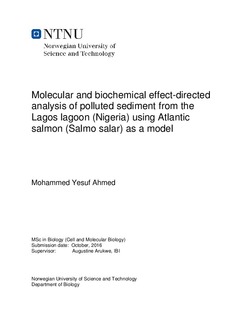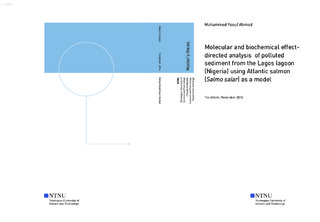| dc.description.abstract | As a result of human interventions, such as agricultural, industrial, and mining activities and urbanization, there have been release of vast range of synthetic and natural environmental pollutants, such as persistent organic pollutants (POPs) and polycyclic aromatic hydrocarbons (PAHs). The ultimate sink for these chemicals or their degradation products is the aquatic environment and eventually accumulated on the sediments, which may be taken up by benthic organisms, as a result of direct contact with polluted sediment or indirectly via food and water. Therefore, these have ultimately caused a constant threat for the aquatic organisms and significant loss of biodiversity in the aquatic ecosystem. It has been suggested that human activities in and around Lagos lagoon are the major sources of PAHs, which may lead to a huge reduction in fishery resources and threatening their sustainability. Previous studies revealed that water samples from the lagoon contains a wide range of organochlorine pesticides (OCPs) and phthalic esters and the sediment samples contain higher concentration of polychlorinated biphenyls (PCBs) and heavy metals. Moreover, different studies showed that fish species inhabiting the Lagos lagoon system suffer from severe intersex, developmental and reproductive effects and fish exposed to sediment extracts from the Lagos lagoon showed teratogenic, embryotoxic and genotoxic effects. Thus, more studies to establish the state of pollution in relation to detrimental effects to the health of the ecosystem and humans in the Lagos lagoon is needed and recommended. Therefore, the aim of the present study was to further investigate and document whether the overt physiological and health effects observed at the Lagos lagoon were due to accumulated contaminants in sediment samples, using the Atlantic salmon, Salmo salar as a model. The sediment samples were collected from Makoko and Ikorodu sites of the Lagos lagoon and both polar and non-polar pollutants were extracted from each sediment samples using an ultrasonic extraction procedure. In the present study, juvenile Atlantic salmon were exposed to polar and non-polar sediment extracts, 17α-ethynylestradiol (EE2: 2.5 µg/ml), and the carrier solvent dimethyl sulfoxide (DMSO: 0.016 %). As phase I enzyme, hepatic CYP1A1 catalytic responses were performed by ethoxyresorufin O-deethylase (EROD), methoxyresorufin O-demethylase (MROD), and benzyloxyresorufin O-debenzylase (BROD). The antioxidant enzymes, such as glutathione reductase (GR), glutathione S-Transferase (GST), glutathione peroxidase (GPx), and catalase (CAT) were also investigated. Gene expression levels of CYP1A1 and CYP3A genes in relation to their xenobiotic biotransformation activity and vitellogenin (Vtg) and zona radiata protein (Zrp) in relation to their estrogenic activities were also analyzed with Real-time RT-PCR. Makoko polar and Ikorodu non-polar exposure produced higher EROD enzymatic activities whereas EE2 exposure produced a significant reduction of EROD. Regarding oxidative stress, generally, all the exposure groups exhibited reduced GR activities and increased GST catalytic activities. The gene expression patterns of hepatic CYP1A1 and CYP3A mRNA didn t show any significant difference from the control group. Salmon exposure to EE2 in this study produced significantly higher levels of Vtg, Zrp, and ERα and reduction in the expression of CYP1A1 mRNA whereas Makoko polar extract and Ikorodu non-polar extract created insignificant estrogenic responses. Thus, the higher EROD catalytic activities exhibited by both Makoko polar extract and Ikorodu non-polar extract may be a response to AhR ligand exposure and an indication of toxic planar compound uptake in fish. Generally, the higher GST catalytic activities in both the Makoko polar and the Ikorodu non-polar exposure groups may be a reflection of the amount of analyzed PAHs at the two sediment sampling sites. Regarding oxidative stress, the reduction of the antioxidant enzymatic activities in this study may be an indication of deficiency of the system as a result of high levels of pollutant exposure. This may indicate that GST might function more as a detoxification activity than as an antioxidant defense activity. In this study, all the exposure groups showed non-significant small increase and decrease of Vtg, Zrp, and ERα. Therefore, the unaffected estrogenic responses may indicate that the estrogenic compounds in the sampled sediments may not be found at the levels that produce estrogenic effects or other contaminants in the sediments may antagonize and reduce the estrogenic effects. Therefore, the exposure of salmon to sediment extracts from Makoko and Ikorodu sites of the Lagos lagoon system showed biotransformation of xenobiotics, failure in antioxidant defense system, and unaffected estrogenic responses, which may be an indicative of potential and adverse health effects that need further studies. | |

